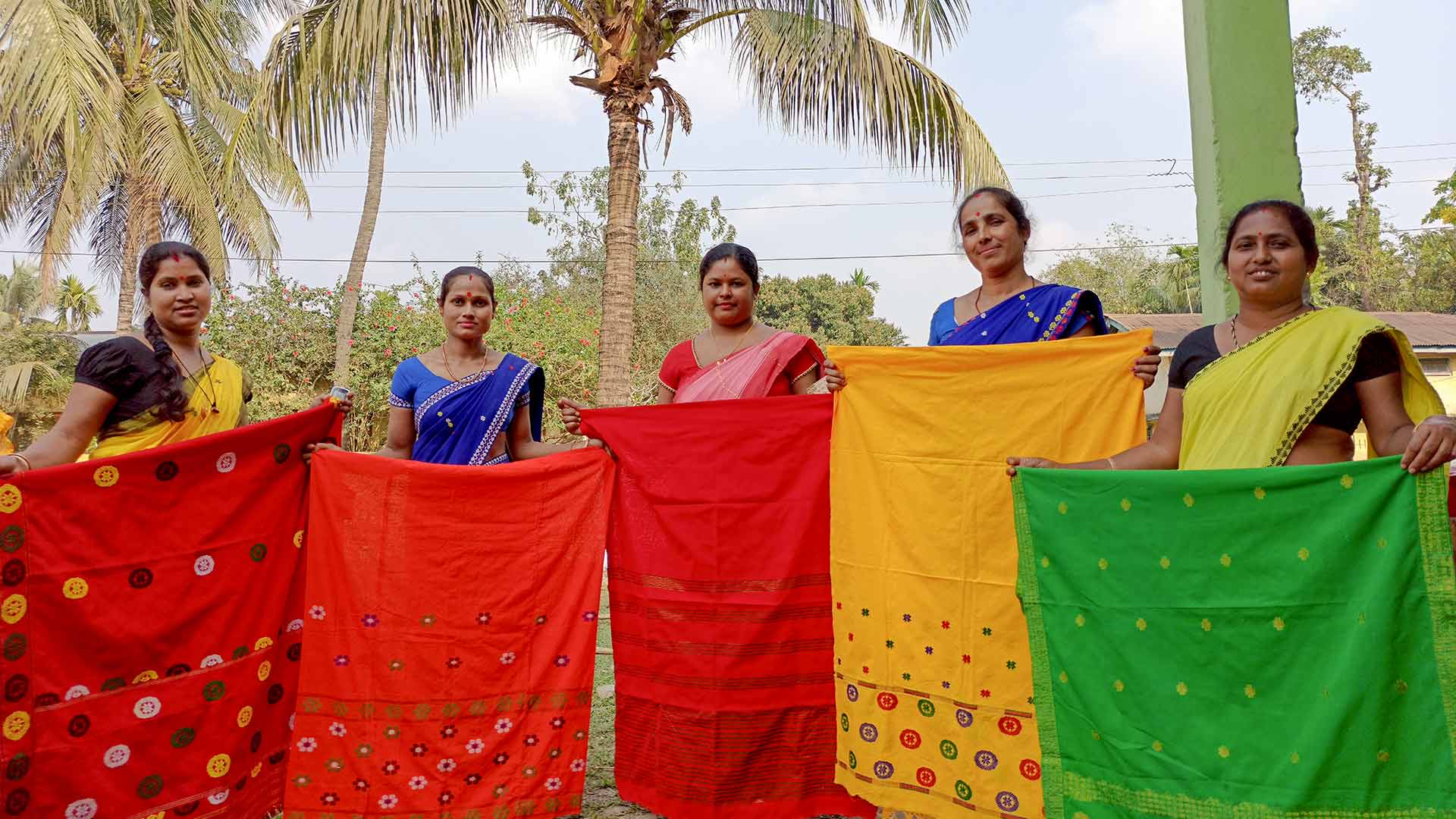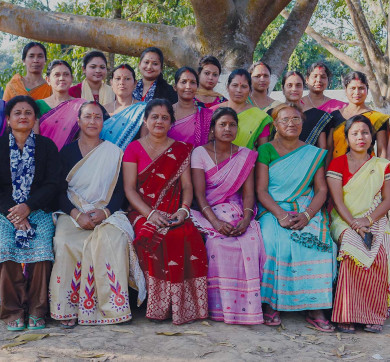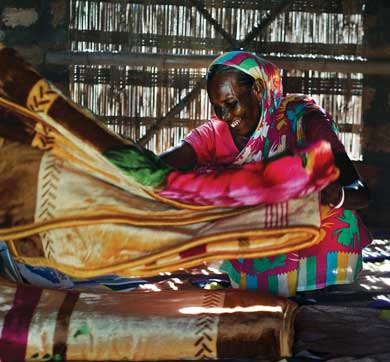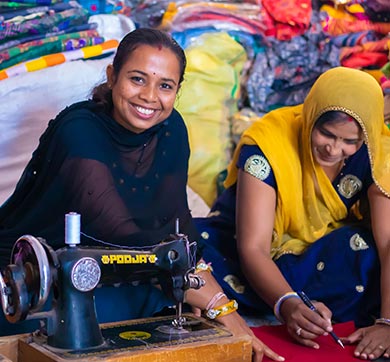August 2023 | 2462 words | 9-minute read
Mina Bibi had never been in an aeroplane until last year. The prospect terrified her so much she was close to tears at the airport. But once the flight took off and levelled out, Ms Bibi relaxed and began to enjoy the experience. “I never imagined I would fly one day,” says the 37-year-old resident of Natun Simina village in Assam’s Kamrup district. “But then, I never thought I would one day be an entrepreneur, either. Now I can say I’ve done both.”
It was December 2022 and Ms Bibi was flying to Chennai for an exhibition, carrying a haul of sarees, stoles, dupattas (scarves), curtains, cushion covers, table runners and more that she and others from her village had woven on their looms. The trip was a success, with the group managing to sell most of their wares.
Ms Bibi is one of about 1,200 artisans across the districts of Kamrup and Nalbari that have made weaving their primary source of income. This has been possible thanks to a crafts-based livelihood programme introduced by the Tata Trusts in Assam through their associate organisation, Centre for Microfinance and Livelihood (CML). Called Antaran, the initiative’s objective is to revive weaving among various indigenous communities in the state.

“Weaving is passed down from mother to daughter in Assam and generations of women have engaged in it,” says Mridula Tangirala, head, tourism, anchoring non-farm livelihoods at the Trusts. “This was mainly a subsistence exercise, though, with women weaving only for their families and themselves.”
That meant crafting the traditional gamosa (a multiple-use, rectangular piece of cloth) for men and mekhala chadors (a two-piece garment similar to a saree) for women. Weaving happened only when necessary, before festivals or if new clothes were needed. The looms sat idle the rest of the time. “Many women would give up weaving once they got busy with household duties post marriage,” adds Ms Tangirala. “It needed to be revived and turned into an income source.”
Syed Ruhul Kuddus, an area manager with CML who hails from Golaghat district, saw the decline close up. “My grandmother used to weave but my mother didn’t, and neither did my sister,” he says. “Weaving was dying in families like mine because one or the other generation discontinued it.”

‘We have inspired many’
Jyotshna Kalita started weaving at 14, having learned it from her mother and grandmother. But this resident of Nahira village in Kamrup district has never spent as much time on her loom as she had in the last three years.
“I didn’t think weaving could ever become a business for me,” says the 41-year-old homemaker-turned-entrepreneur. “Before our training with Antaran, we had no idea that we could sell our products online.” Ever since she opened an Instagram account in 2020 and started uploading photos of her products, Ms Kalita has been inundated with orders from across India. Even with eight other weavers working with her, some orders take up to three months to complete.
The lockdowns were the busiest time for Ms Kalita. “I connected with customers over social media and sought their opinions about the designs and colours they wanted,” she says. “Then, as soon as courier services reopened, we sent the items across.”
Ms Kalita is starting to think about expanding her venture, Aalok Handlooms. She wants to buy a Jacquard, a loom attachment that enables weavers to create more complicated designs. This will help improve her products as her current foot-operated loom is quite limiting.
This loom lady’s contribution to the family kitty is now more than that of her husband. Ms Kalita makes, on average, Rs 15,000- Rs 20,000 a month and runs the household on her earnings. “I was married at 19 and I used to make clothes for the people in my neighbourhood, just to get some money in hand,” she says. “I used to think that was enough, but not now. I don’t ask my husband for money anymore; I have my own source of income. Antaran has made that possible.”
Ms Kalita’s sisters-in-law, Kabita and Renuka, have also come under Antaran’s canopy and started businesses of their own. “People say we’re a lucky family because the three of us have found this lucrative opportunity and become successful,” says Ms Kalita. “We’ve inspired many others in our village to take up weaving full-time.”
A cultural habit
Meanwhile, in neighbouring West Bengal, people had taken up weaving in a professional way and turned it into a regular source of income. In Assam this remained a cultural habit, with women sitting at the loom only if they had time. “We needed to change that mindset and show them that weaving could be a lucrative, even primary, source of income,” adds Mr Kuddus. “That was our first challenge.”
In 2018, the Antaran programme was launched in Assam. The idea was to make weaving sustainable and to nurture an ecosystem that would benefit all categories of artisans. The more enterprising and better off could start small businesses of their own. Weavers who didn’t have the means to do that could work for the artisan entrepreneurs. Naturally enough, the Antaran effort was targeted principally at women.
Agriculture is the mainstay of the indigenous communities in Kamrup and Nalbari. But expanding families and primitive cultivation practices have reduced farming yields for small landholders. What they produce is sometimes not enough to even feed their family. With no surplus to sell, cultivators have been struggling to make ends meet.
Since it started operating in Assam in 2012, CML has tried to introduce other kinds of livelihood means, such as the cultivation of high-value crops and animal husbandry. The goal was to ensure that participating households could generate an additional income of Rs 60,000-Rs 80,000 a year.
It was imperative to draw on all possible options, including weaving. It is in this context that Antaran has made a substantial difference to the lives of artisans in the programme. In many instances, especially with artisan entrepreneurs, family incomes have jumped by Rs 200,000 to Rs 800,000 per year. “We had to provide local weavers with training,” says Sulagna Sen, cluster lead, Kamrup, for Antaran. “They already had the skills; we needed to make their products more marketable.”

No loom limits now
The Antaran intervention has been three-pronged. It began with providing technical know-how to help artisans understand and manage their craft better. While almost every household has a loom, these were homemade contraptions fashioned out of bamboo, palm trees or whatever wood was available. This was limiting. Loom care and expertise in repairs were required, and Antaran’s trainers stepped in to lend a hand.
In the second part of the intervention, the trainers imparted knowledge about design, colour, composition, layout and enlarging the portfolio of products that could be woven. “Passing the skills down through generations was not enough,” adds Ms Sen. “Weavers had to refine their products and make them more appealing to national and international customers.”
Sarees, stoles, dupattas, kurtas (a tunic, waistcoat or shirt), table linen and various kinds of home furnishings were added to the weavers’ repertoire. They were urged to use new kinds of material. While this region is known for its cotton and eri (an indigenous silk), over the years the price per bolt of these fabrics has gone up so much that local people can only afford polyester and other cheap synthetics.
Antaran took it upon itself to buy bolts from manufacturers directly and lend them to the artisans so that they can make samples from which they can get more orders.
Dyeing was another problem. The cheap cotton that weavers could afford was usually of such poor quality that it would frequently bleed. To deal with the issue, CML is now trying to set up natural dyeing units in the different villages of the Kamrup cluster.
As dyeing was an issue, most artisans would make gamosas and mekhala chadors in white, off-white or brown, with a red or green border. After training, their palette now includes pastels and bright colours, with better-quality dyed yarns or even natural yarns, as suggested by the trainers.

‘Antaran has changed our lives’
With an annual income of more than Rs 200,000 from weaving, 45-year-old Pratibha Kalita is one of the big success stories of the Antaran initiative. This resident of Rampur in Kamrup joined the project in 2019 and started her own company, Chandrodoy Weaves, soon after. Ms Kalita employs eight other artisans — all women, because she wants them to become financially independent like her.
Ms Kalita isn’t resting on her laurels. She’s opened bank accounts for her two teenaged daughters and has started putting funds aside for them. She has also taken an insurance policy for herself. “I would never have thought of all this if it hadn’t been for my association with Antaran. It opened up my mind.”
Ms Kalita has bought a refrigerator and an inverter for her home, both on loan. And, unlike previously, she doesn’t worry about where the money to repay the loans will come from.
“Before Antaran, my creations were restricted to gamosas and mekhala chadors. Now I make sarees, stoles, dupattas, shawls and lots of home furnishings,” says Ms Kalita. “I use vibrant colours and have begun to craft cotton and light-coloured garments for summer and eri silk items for winter. It was Antaran’s trainers who taught me, among other things, the nuances of seasonal clothing.”
Ms Kalita has begun to experiment with new designs: stoles with palm leaf-inspired motifs are her bestsellers. These were sold out at the Antaran-organised exhibitions Ms Kalita has been to in Jaipur, Mumbai and Kolkata.
“The Antaran project has been a huge blessing,” says Ms Kalita, “not just for me and my family but for every single person who works with me or is associated with my enterprise. Being part of the programme has changed our lives.”
In with the new
Antaran has also introduced new motifs to the weavers. The traditional floral ‘bootas’ and geometric patterns of the tribal communities have expanded to include trees, plants and animal motifs. “We have introduced new motifs but we try to keep the language the same so that it can be identified as distinctly Assamese,” adds Ms Sen. “We show the weavers how to play around with their existing motifs, and also take inspiration from the world around them.”
The third, and arguably most important, part of Antaran’s programme concerns providing a market connect for the weavers. Social media is one part of that. With mobile penetration, weavers in even the remotest parts of the state have cellphones. After receiving training, many artisan entrepreneurs have opened social media accounts on Instagram, Facebook or WhatsApp and uploaded photos of their products. They have also begun to receive orders online, from India as well as abroad.
Antaran promotes artisans through its social media platforms and has helped some of the entrepreneurs among them create a brand. The trainers encourage the entrepreneurs to post different kinds of content around their products. This move has brought families together, with many of the children of weavers managing their parents’ online marketing and sales. Not surprisingly, youth who were disinclined earlier are now reconsidering weaving as an option.
Megha Kalita, 17, who has just finished her higher secondary exams, manages her mother Jyotshna’s social media accounts. “I was not sure if I wanted to take up weaving, but after watching my mother I want to do this business myself,” she says. “My mother gets so much respect from everyone because of her work. I’m interested in designing garments. So, when I finish my studies, I will join her. Together we will expand the business.”

Unstoppable senior
At 62, Manju Das Kalita didn’t have much reason to step out of her village of Amtola in Kamrup district. That was till recently. Now she travels to Boko, about 12km away, once or twice a week for work.
That’s because in 2022, Ms Kalita started her own weaving business after receiving training under the Antaran project (she was one of the oldest to do so). She currently has 10 weavers working with her. Since two of them live in Boko, she visits regularly to check on their work.
Undeterred by age and a stroke she suffered some years ago, Ms Kalita is determinedly growing her enterprise, Maa Weavers. “I started weaving when I was in Standard X,” she says, “but I gave it up once I went to college. Then, at 35, when my children were older, I took it up again.”
Ms Kalita had always depended on weaving for some extra money. Before she formally started her label, she would weave gamosas — sometimes as many as 100 a month — with the help of two other artisans and sell them at melas (fairs) in Guwahati. The sales, however, were nothing to speak of; gamosas are made by every other weaver in Assam.
Antaran changed all of that for Ms Kalita. She has expanded her customer base, and to foreign countries too, recently shipping 80 silk stoles to a buyer in the United States (via a Kolkata contact). “They got in touch with me over social media,” she says. “I needed my son to download Instagram and WhatsApp on my phone, but I operate them myself. I have become tech-savvy.”
Ms Kalita has done a fair bit to bolster the family income. Her husband, who retired as a police officer, manages the family’s agricultural plot and makes Rs 30,000-Rs 40,000 every three months (during cultivation periods). Ms Kalita has added Rs 60,000-Rs 70,000 a year to the family’s financial pool through weaving.
“I’m constantly thinking of ways to better my business,” she says. “I don’t have enough money right now, but as soon as I do I’m going to go all out.”
Customer connect
The Antaran team organises exhibitions in different metros from time to time and invites artisans to showcase their products there. “This is immensely helpful,” says entrepreneur Pratibha Kalita. “We get to interact directly with potential customers and understand exactly what they want: colours, designs and even the pieces that they prefer.”
Antaran has been successful in making weavers independent with a proven method. It provides training free of cost, facilitates the procurement of raw materials at competitive prices, connects the weavers to the market in such a way that customers as well as higher profit margins are enabled, and lends support with technology and design inputs. Financial matters (invoicing, pricing, etc) are left to the weavers.
“I can’t thank the Antaran team enough for what they have done for us,” says artisan entrepreneur Manju Kalita, who, at 62, is enjoying financial independence for the first time in her life (she contributed about Rs 150,000 to her family’s income last year from weaving). “They’ve given our age-old tradition, as well as us, a new lease of life.”
—Labonita Ghosh
Source: Tata Trusts’ Horizons, April 2023 issue




















